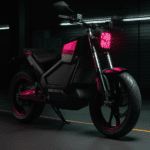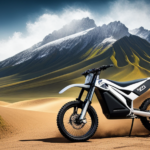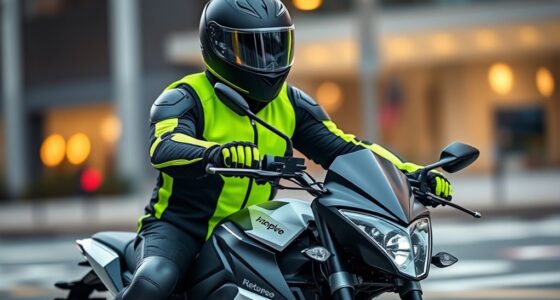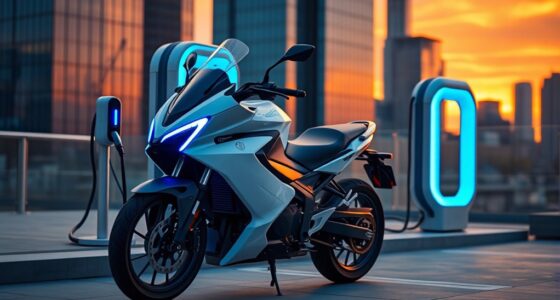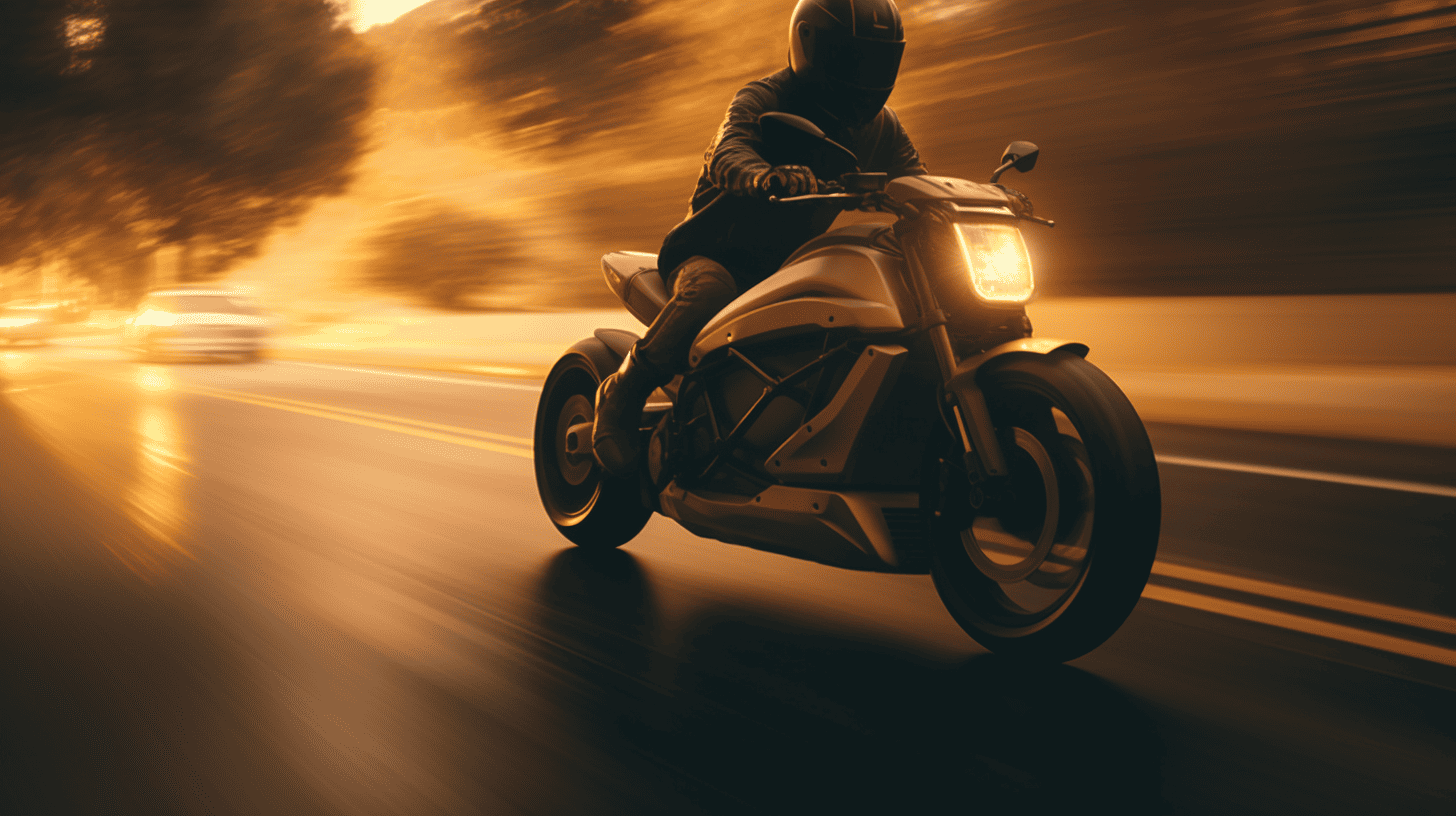When comparing electric motorbikes and traditional motorcycles, you’ll find electric bikes offer instant torque, lower maintenance, and are better for city riding with quick charging options, while traditional bikes provide higher top speeds, longer ranges, and a richer riding experience with engine sounds and gear shifts. Electric models are eco-friendly and cheaper to operate over time, but traditional bikes excel for longer trips and adventure touring. Explore further to discover which choice suits your lifestyle best.
Key Takeaways
- Electric bikes offer instant torque, quick acceleration, and quieter, smoother operation, ideal for city commuting and urban agility.
- Traditional motorcycles provide higher top speeds, longer ranges, and a more tactile riding experience with engine sound and gear shifts.
- Electric bikes have lower upfront costs, reduced maintenance, and cheaper charging, while traditional bikes benefit from established fuel infrastructure for long-distance travel.
- Electric motorbikes produce zero tailpipe emissions, contributing to better air quality and sustainability, whereas petrol bikes emit pollutants and CO2.
- Electric bikes are increasingly supported by expanding charging networks and renewable energy, making them suitable for future green transportation needs.
Performance and Power Comparison

Electric motorcycles deliver instant torque, meaning you’ll experience rapid acceleration right from the start. This immediate power delivery makes acceleration smoother and more responsive compared to traditional bikes, which often require RPM buildup. With models like the HappyRun Tank G50 offering over 120 Nm torque, you get up to 30% faster 0-60 mph acceleration. While electric bikes generally have a top speed lower than some gasoline motorcycles—though models like the Lightning LS-218 reach up to 218 mph—they excel in efficiency and urban agility. Their range varies from 70 to 150 miles, enough for city commuting, but less suited for long-distance rides. Overall, electric bikes provide impressive torque and acceleration, delivering power efficiently while prioritizing quick responsiveness over top speed and extended range. Proper installation and maintenance of electric motors ensure optimal performance and safety.
Cost and Maintenance Analysis
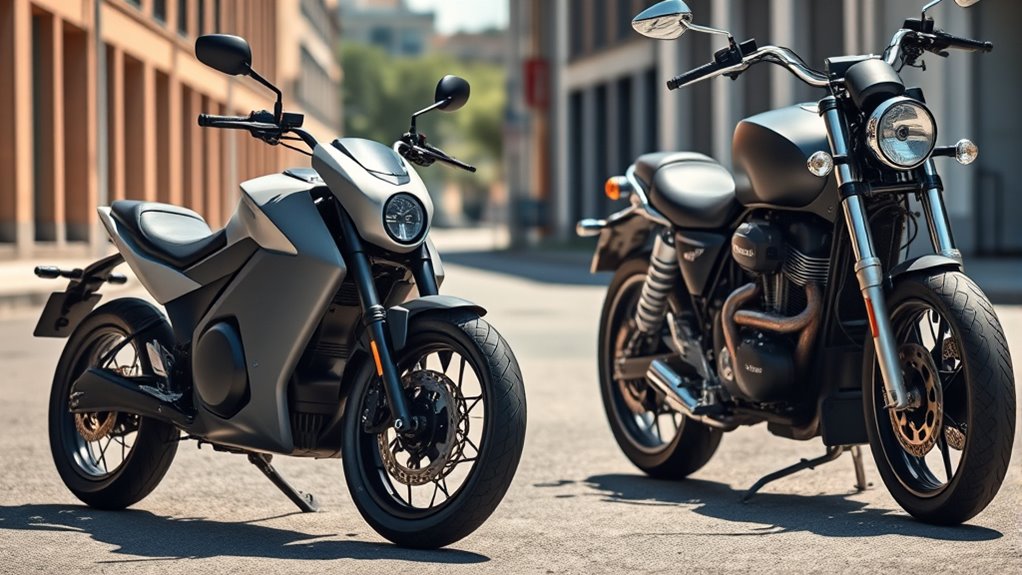
Have you considered how much money you’ll save on maintenance and fuel costs with an electric motorcycle? Electric motorcycles generally have a lower upfront cost and considerably reduce ongoing expenses compared to traditional bikes. They eliminate routine maintenance like oil changes, spark plug replacements, and exhaust system checks, cutting maintenance costs by about 60%. Charging an electric bike is cheaper than refueling a petrol motorcycle, especially with off-peak electricity rates, leading to notable fuel savings. Maintenance mainly involves checking the battery, brakes, and tires, which requires less time and money. The battery technology used in electric motorcycles continues to improve, increasing their reliability and lifespan over time. While some electric models have a higher initial price, the long-term savings on fuel and maintenance make them a more economical choice over their lifespan. Additionally, electric motorcycles often feature advanced battery technology, increasing their reliability and lifespan over time. Moreover, the electric drivetrain produces no emissions, contributing to a cleaner environment and potentially reducing regulatory restrictions on usage. An increasing number of riders are also considering cost-effective transportation options to manage their budgets better. For many riders, the environmental benefits of electric bikes are a significant advantage, aligning with sustainable transportation goals.
Environmental Impact and Sustainability
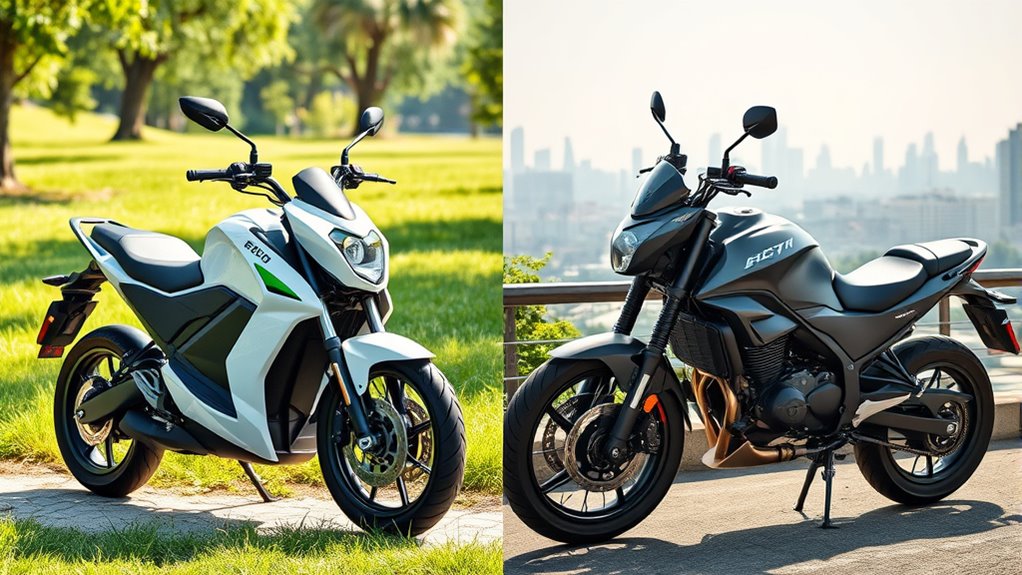
Electric motorbikes produce no tailpipe emissions, helping you reduce air pollution in cities. When charged with renewable energy, they lower lifecycle emissions by about half, making them more sustainable. By choosing electric, you’re contributing to cleaner air and a healthier environment. Additionally, cost and budgeting considerations can influence your choice between electric and traditional motorcycles, impacting long-term affordability and investment. Incorporating sustainable transportation practices can further enhance your environmental benefits and promote responsible consumption. Moreover, adopting electric motorbikes supports renewable energy integration and reduces reliance on fossil fuels. Studies also show that electric vehicles can encourage the development of green infrastructure, benefiting urban planning and climate resilience. Transitioning to electric motorbikes can also promote energy resilience by reducing grid stress during peak times and supporting the grid with stored energy.
Zero Emission Benefits
Since electric motorbikes produce no tailpipe emissions, they considerably reduce air pollutants compared to traditional motorcycles. This zero tailpipe emissions benefit leads to cleaner urban air and better health. Lifecycle analyses show that when charged with renewable energy, electric bikes can cut overall carbon footprints by up to 50%. This reduction in greenhouse gases supports global sustainability goals. The table below highlights key environmental benefits:
| Benefit | Impact | Example |
|---|---|---|
| Zero tailpipe emissions | Eliminates nitrogen oxides and particulates | Improves air quality |
| Carbon footprint reduction | Less CO2 released during lifecycle | Supports climate goals |
| Environmental impact | Minimizes battery disposal effects | Battery recycling initiatives |
Adopting electric bikes helps you contribute to a cleaner environment and a sustainable future. Lifecycle analysis is essential for understanding the full environmental impact of electric bikes and their potential benefits. Additionally, advancements in hydrogen fuel cell technology could further enhance the sustainability of electric transportation options in the future. Incorporating renewable energy sources into the charging process can further amplify these environmental advantages. A comprehensive approach to sustainability involves improving battery recycling techniques and renewable energy integration to maximize environmental benefits.
Renewable Energy Sources
Powering electric motorcycles with renewable energy sources like wind, solar, and hydro drastically enhances their environmental benefits. When you charge your bike using green energy, you significantly reduce its carbon footprint, especially compared to traditional fuel-based bikes. Advances in recycling technologies now reclaim up to 92% of lithium in batteries, minimizing environmental impact. Building robust charging infrastructure with renewable energy further supports sustainability. Switching to renewable energy for charging eliminates greenhouse gas emissions associated with electricity generation, making electric bikes more eco-friendly and sustainable. Increased investments in green energy, particularly in the UK, are vital for supporting this transition. By choosing renewable energy sources, you’re helping to create a cleaner, greener future, reducing reliance on fossil fuels, and promoting the long-term sustainability of electric motorbikes. Additionally, utilizing vetted Halloween product reviews ensures that consumers are informed about eco-conscious and high-quality accessories, supporting sustainable practices in the industry. Incorporating renewable energy-powered charging stations can further enhance the eco-friendly appeal of electric bikes. Moreover, advances in energy storage technologies will improve the efficiency and reliability of renewable-powered charging stations, which are crucial for long-term sustainability and widespread adoption of electric vehicles.
Pollution Reduction Impact
Switching to electric motorbikes dramatically reduces air pollution and noise levels in urban areas. With zero tailpipe emissions, you cut down on harmful pollutants that contribute to smog and respiratory issues. Electric bikes produce markedly less noise pollution, creating quieter, more livable cities—up to 75% quieter. Their lifecycle emissions are about 50% lower when powered by renewable energy, helping combat climate change. While manufacturing and recycling batteries account for part of their environmental impact, recycling initiatives reclaim over 90% of lithium, reducing waste. By eliminating exhaust gases and particulate emissions, electric motorbikes improve air quality and promote sustainability. These benefits highlight how switching to electric bikes supports cleaner air, quieter communities, and a healthier planet. Additionally, the increasing availability of cruise FAQs ensures consumers are well-informed about environmental policies and safety protocols related to electric vehicles and sustainable travel.
Infrastructure and Charging vs. Fueling Networks
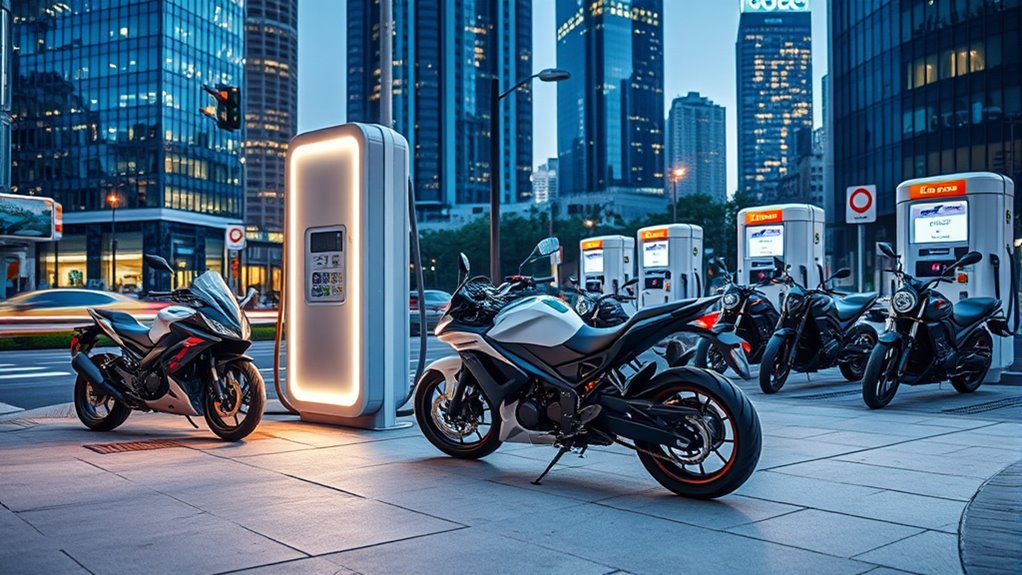
Electric motorbikes benefit from a growing network of public charging stations, especially in urban areas and along highways in the UK, making refueling more accessible than ever. Fast chargers can recharge an electric bike to 80% in about 30 minutes, but full charges often take 6 to 8 hours with standard home chargers. In contrast, traditional motorcycles benefit from an extensive refueling network of petrol stations scattered across the UK, providing convenience everywhere. However, limited fast charging infrastructure in rural areas challenges long-distance travel for electric bikes. To visualize this, here’s a comparison:
| Aspect | Electric Motorbikes | Traditional Motorcycles |
|---|---|---|
| Infrastructure | Growing, urban-focused | Well-established, widespread |
| Charging Time | 30 min (fast chargers) | Instant refueling |
| Long-distance | Limited by charging network | Easy with petrol stations |
This highlights the evolving infrastructure for electric bikes versus the reliable refueling network of traditional motorcycles.
Ride Experience and Practicality

Riding an electric motorbike offers a quiet, smooth experience with instant torque, making city commutes more effortless and enjoyable. Electric bikes excel in practicality, thanks to their compact size and nimbleness, which help you navigate crowded urban streets easily. The ride experience is seamless, with less vibration and no engine noise, appealing to those seeking a relaxing, hassle-free ride. In contrast, traditional motorcycles provide a tactile, visceral feel with engine sounds and gear shifts, favored by riders who enjoy the classic motorcycling experience. When it comes to practicality, electric bikes require less maintenance and offer quick, clean charging, ideal for daily city use. Conventional motorcycles, however, often have longer ranges and faster refueling, making them more suitable for longer journeys and highway adventures.
Safety Features and Reliability

When it comes to safety and reliability, electric motorbikes are increasingly equipped with advanced features that enhance rider protection. They feature hydraulic disc brakes and advanced shock absorbers, providing reliable stopping power and smoother rides. Safety features such as front and rear brakes, LED lighting, and sometimes ABS systems help prevent accidents and improve visibility. Electric bikes tend to have fewer mechanical failures because they have fewer moving parts, boosting overall dependability. Modern safety testing ensures these bikes meet high standards, and digital safety aids like regenerative braking systems and electronic stability controls add extra layers of security. While traditional motorcycles have a proven track record, electric models are catching up fast, offering innovative safety features that help keep you protected on the road.
Range, Speed, and Travel Distance

Your choice between electric and traditional motorcycles impacts how far you can go and how quickly you can get there. Petrol bikes usually cover more miles per tank and refuel in minutes, while electric bikes often require longer charging times, though some have swappable batteries for extra range. Consider how the available charging infrastructure and your typical riding distances influence your decision.
Range Capabilities and Limitations
Electric motorbikes generally have a shorter range compared to traditional motorcycles, with most models traveling between 70 and 150 miles per charge, whereas petrol bikes often cover 150 to 300 miles per tank. This limited range poses challenges for long-distance travel and requires careful route planning, especially in areas with fewer charging stations. Electric motorcycles face range limitations that can impact your trip, though some models offer extended range options through swappable batteries, providing more flexibility. In contrast, traditional motorcycles typically offer greater travel distances with quick refueling times, making them more suitable for lengthy journeys. Advances in battery technology are gradually increasing electric motorcycle ranges, but for now, their limited range remains a key factor in considering their use for extended trips.
Top Speeds and Acceleration
Electric motorcycles have made impressive strides in top speeds and acceleration, with models like the Lightning LS-218 reaching up to 218 mph, outpacing many traditional bikes. Their performance at high-speed is driven by instant torque, delivering rapid acceleration from a standstill and smooth power delivery at speed. Most mainstream electric bikes reach top speeds between 90 and 120 mph, comparable to many petrol-powered motorcycles, while high-performance models exceed that, making them suitable for spirited riding. Although traditional motorcycles often surpass 180 mph, electric bikes excel in acceleration and handling at lower to moderate speeds. Range remains a key factor; electric bikes typically travel 70 to 150 miles per charge, limiting high-speed touring. Still, their quick acceleration and impressive top speeds showcase their growing performance capabilities.
Charging Infrastructure Availability
As the popularity of electric motorbikes grows, so does the development of charging infrastructure, especially in urban areas and along major highways. You’ll find an increasing number of charging stations, making it easier to recharge on the go. Fast chargers can top up your bike to 80% in about 30 minutes, supporting longer trips and reducing downtime. The typical range of electric bikes varies from 40 to 100 miles per charge, influenced by terrain and riding habits. Home charging offers a convenient option for overnight recharges, often using standard outlets or dedicated fast chargers. However, rural areas still have limited infrastructure, which can affect long-distance travel plans. Overall, expanding charging stations enhances the practicality of electric motorbikes for daily use and longer journeys.
Market Trends and Future Outlook
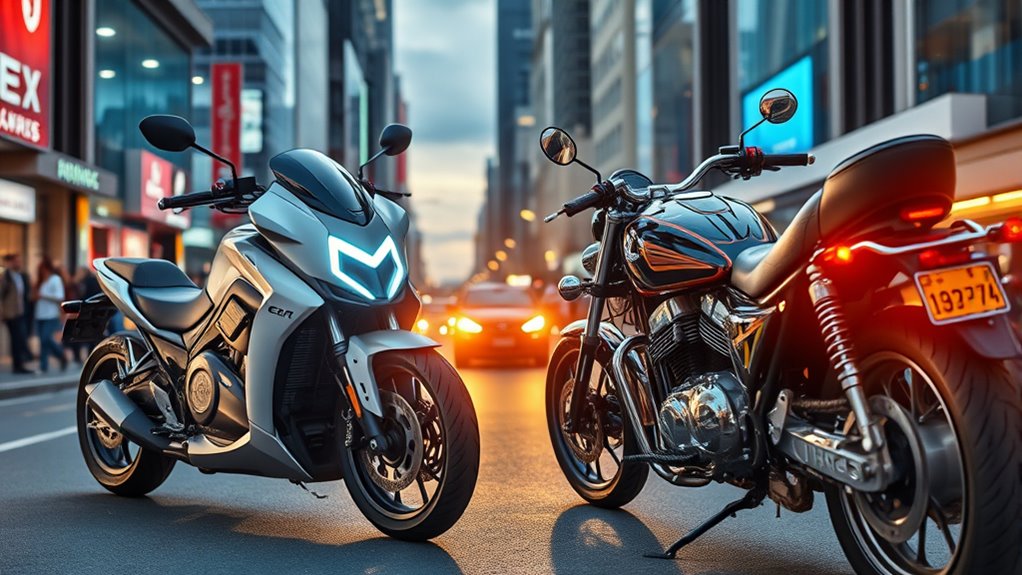
The market for electric motorcycles is showing robust growth, fueled by technological advancements and increasing environmental concerns. The electric motorcycle market is projected to grow at around 8% CAGR from 2023 to 2030, driven by innovations that boost performance and range. Major manufacturers are investing heavily in developing bikes that can reach over 200 mph and travel beyond 150 miles per charge, aligning with industry trends toward higher performance. Government incentives, stricter emissions regulations, and improved charging infrastructure in countries like the UK are accelerating adoption. Industry analysts forecast that by 2030, electric bikes could make up over 30% of the global two-wheeled vehicle market, marking a significant shift toward sustainability and a promising future outlook for electric motorcycle market growth.
Personal Suitability and Lifestyle Fit
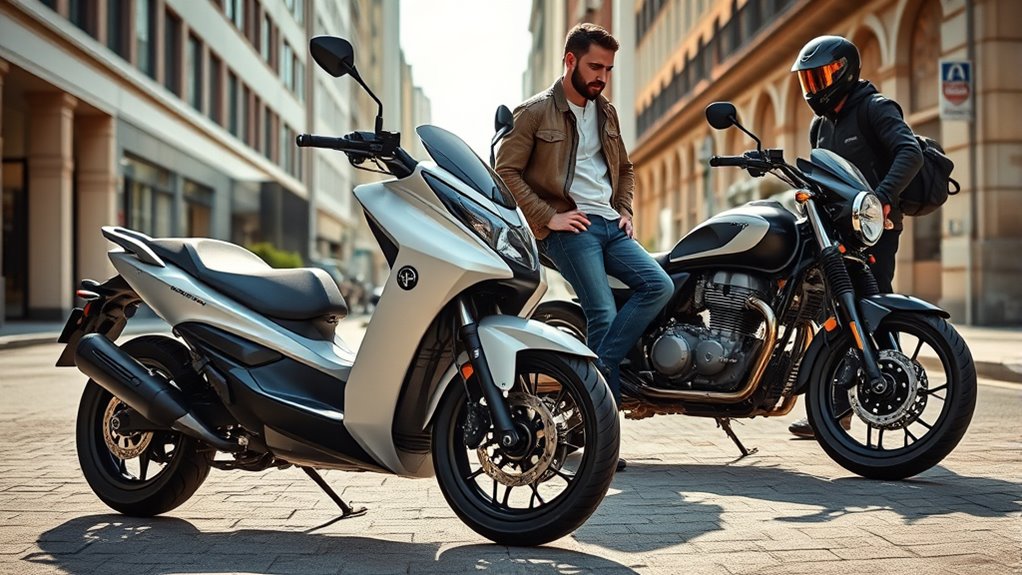
Choosing between electric motorbikes and traditional motorcycles depends largely on your lifestyle and riding preferences. If you mainly commute within the city, electric bikes are a great fit—they’re quiet, easy to maneuver, and have lower maintenance costs, making daily urban commuting smooth and hassle-free. They also suit those prioritizing environmental impact, as electric bikes produce zero emissions and can be charged with renewable energy sources. If you enjoy long rides or adventure touring, traditional motorcycles offer longer ranges and higher top speeds, better matching your riding experience. Riders seeking simplicity may prefer electric bikes because they eliminate clutch operation, gear shifting, and routine oil changes. Ultimately, your lifestyle needs—whether daily commuting, eco-consciousness, or adventure—will determine which type of motorcycle aligns best with you.
Frequently Asked Questions
Are Electric Motorcycles Better Than Regular Motorcycles?
You might wonder if electric motorcycles are better than regular ones. Electric bikes offer zero emissions, quieter operation, and lower maintenance, making them ideal for city riding. They deliver quick acceleration and respond instantly, but have limited range and longer recharging times. Traditional motorcycles often go farther and faster with established fueling. Depending on your needs—urban commuting or long-distance rides—electric bikes could be a better, eco-friendly choice for you.
Which Is Better, an E-Bike or a Motorcycle?
When choosing between an e-bike and a motorcycle, it depends on what you value most. If you prioritize eco-friendliness, ease of use, and cost savings, an e-bike might be your best bet. But if you need higher speed, longer range, and travel flexibility, a motorcycle suits you better. Think about your daily needs and preferences—both options offer unique benefits, so pick the one that aligns with your lifestyle.
What Is the Difference Between Old and New Motorcycles?
You notice that old motorcycles have manual gear shifting, loud engines, and need frequent maintenance, while new bikes are quieter, easier to operate with automatic transmissions, and require less upkeep. Modern models often feature digital displays, regenerative braking, and lightweight, aerodynamic designs, boosting performance and efficiency. You also see the range differences—older bikes often go farther per tank, but new electric models offer convenient charging and advanced tech, making riding more comfortable and efficient.
What Is the Difference Between Normal and Electric Bike?
Imagine a roaring lion versus a whispering breeze. Normal bikes, like the lion, run on roaring internal combustion engines, needing fuel and emitting smoke. Electric bikes, the whispering breeze, glide silently on rechargeable batteries, producing zero emissions. You’ll find electric bikes are cleaner, quieter, and require less maintenance, but they often have a shorter range. Your choice depends on whether you crave raw power or eco-friendly, smooth riding.
Conclusion
Choosing between an electric motorbike and a traditional motorcycle ultimately depends on your lifestyle and values. Do you want to ride with a smaller carbon footprint, or do you crave the raw power and extended range of a gas-powered bike? Both options offer unique benefits, but only you can decide which aligns best with your priorities. Whichever you choose, isn’t it time to embrace a journey that reflects your commitment to the future?




